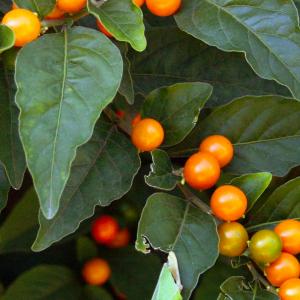文章
Dummer. ゛☀
2017年08月08日

This member of the Solanaceae (Nightshade) family has as bad a reputation as the other members of the family that occur throughout Europe - although one alien species, Thorn Apple Datura stramonium, is naturalised in Europe, having been imported with fertilisers from South America.
Identification
Atropa belladonna, a bushy perennial plant, growto a height of two metres and occasionally more. The pale green oval leaves are pointed and strongly ribbed, and the bell-like purple-brown flowers with five fused petals, 20 to 30mm long, produce shiny green berries that turn black when fully ripe.
Distribution
In Britain, Deadly NIghtshade mainly occurs in southern and eastern parts, but it is a rare find.
This plant occurs also on mainland Europe and western Asia as well as in northern Africa.
Habitat
Atropa belladonna is found mainly on lime-rich soil. Solitary specimens are occasionally found growing at the edgeof shaded areas where limestone chippings had been spread a few years earlier.
Blooming Times
In southern Britain Deadly Nightshade blooms in June, July and August.
Uses
Although Deadly Nightshade has for manyyears been used as a medicine, the glossy black berries of this plant are a potent poison. Cosmetics were once made from this plant, and some people suggest that belladonna refers to the beneficial effects of facial creams based on this plant.

Identification
Atropa belladonna, a bushy perennial plant, growto a height of two metres and occasionally more. The pale green oval leaves are pointed and strongly ribbed, and the bell-like purple-brown flowers with five fused petals, 20 to 30mm long, produce shiny green berries that turn black when fully ripe.

Distribution
In Britain, Deadly NIghtshade mainly occurs in southern and eastern parts, but it is a rare find.
This plant occurs also on mainland Europe and western Asia as well as in northern Africa.
Habitat
Atropa belladonna is found mainly on lime-rich soil. Solitary specimens are occasionally found growing at the edgeof shaded areas where limestone chippings had been spread a few years earlier.

Blooming Times
In southern Britain Deadly Nightshade blooms in June, July and August.
Uses
Although Deadly Nightshade has for manyyears been used as a medicine, the glossy black berries of this plant are a potent poison. Cosmetics were once made from this plant, and some people suggest that belladonna refers to the beneficial effects of facial creams based on this plant.
0
0
文章
Dummer. ゛☀
2017年08月07日

This is one of the lovely bright wildflowers that light up the Mediterranean region and southern Europe in spring and early summer. The plant has distinctive reddish hairy stems.
Distribution
This common and widespread member of the Daisy family (asteraceae, formerly known as the compositae) occurs in France and east towards Turkey and is also present further south including in the Iberian Peninsula.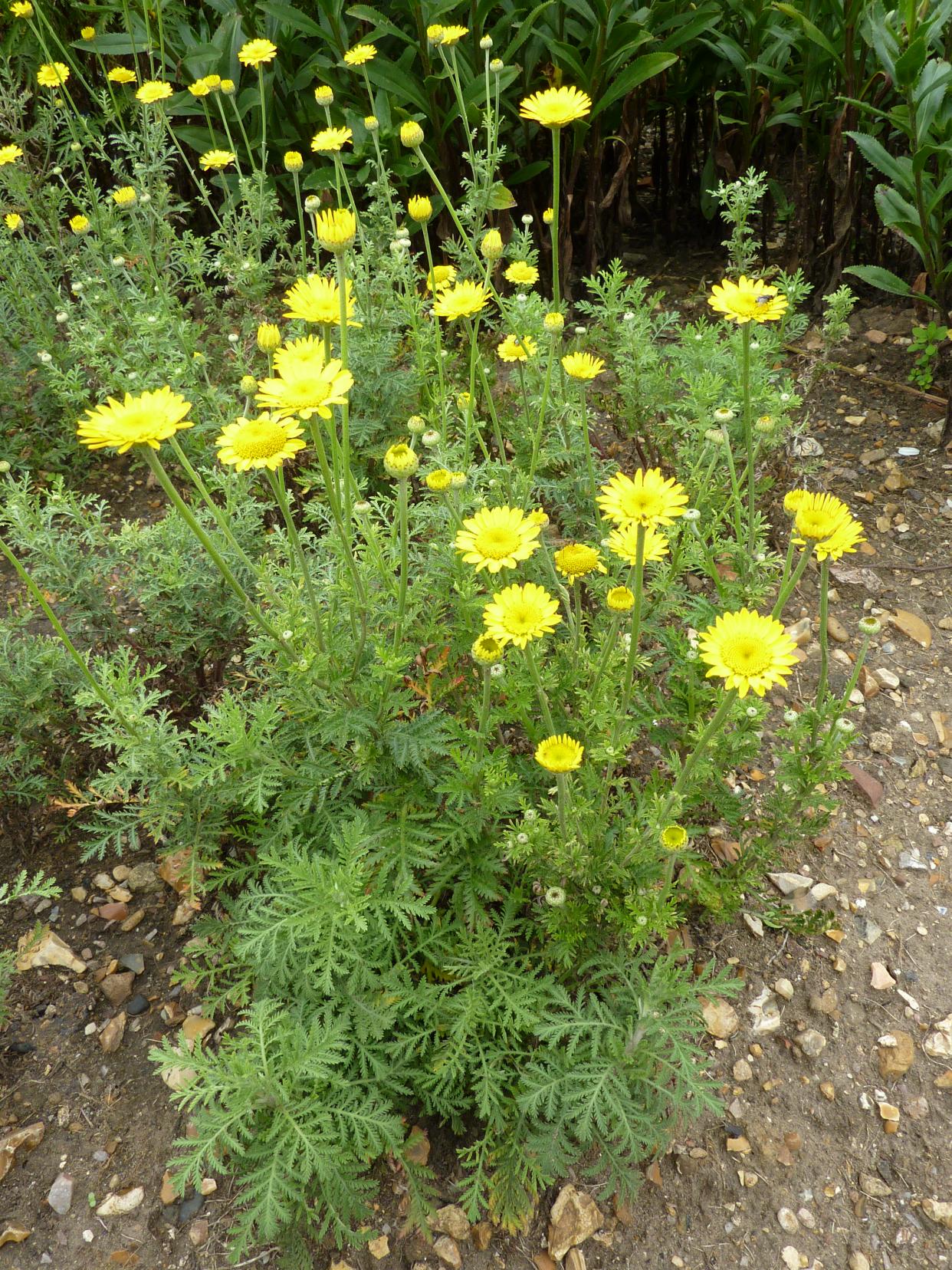
Habitat and Blooming Times
The main flowering period of Yellow Chamomile, a wildflower of dry roadside verges, scrubland and fallow farmland, is from May until September. The Yellow Chamomile plant shown here was photographed in the Algarve region of southern Portugal in May.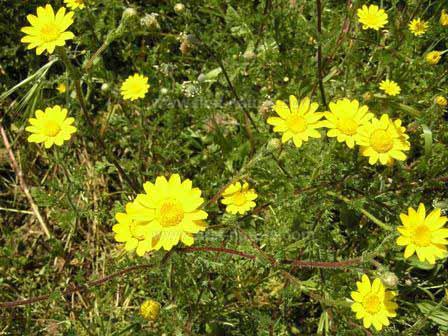
Uses
Yellow chamomile was once used as a source of yellow dye.
Taxonomy
Anthemis, the genus name, comes from the Greek anthemon, meaning flower, and indicates that this plant produces many flowers. The specific epithet tinctoria reflects the fact that these flowers were used to produce dye.

Distribution
This common and widespread member of the Daisy family (asteraceae, formerly known as the compositae) occurs in France and east towards Turkey and is also present further south including in the Iberian Peninsula.

Habitat and Blooming Times
The main flowering period of Yellow Chamomile, a wildflower of dry roadside verges, scrubland and fallow farmland, is from May until September. The Yellow Chamomile plant shown here was photographed in the Algarve region of southern Portugal in May.

Uses
Yellow chamomile was once used as a source of yellow dye.
Taxonomy
Anthemis, the genus name, comes from the Greek anthemon, meaning flower, and indicates that this plant produces many flowers. The specific epithet tinctoria reflects the fact that these flowers were used to produce dye.
0
0
文章
Dummer. ゛☀
2017年08月07日

Distribution
The Criown Anemone is native to the Mediterranean region of Europe, but because of its beauty this lovely wildflower has been taken in to cultivation and can be seen in parks and gardens in many other parts of the world.
In 2013 Anemone coronaria was chosen as Israel's national flower.
Habitat and Blooming Times
Anemones generally shun dry places, and so woodland edges and damp grassland are places where these kinds of flowers are most likely to be seen. Anemone coronaria blooms from January to April and can be found on roadsides, meadows and the grassy slopes in the hills.
The Crown Anemone Anemone coronaria is the most common of the many anemone species that occur in the Mediterranean region of Europe, where they are frequently grown in gardens as well as being found in the wild.
The Criown Anemone is native to the Mediterranean region of Europe, but because of its beauty this lovely wildflower has been taken in to cultivation and can be seen in parks and gardens in many other parts of the world.

In 2013 Anemone coronaria was chosen as Israel's national flower.
Habitat and Blooming Times
Anemones generally shun dry places, and so woodland edges and damp grassland are places where these kinds of flowers are most likely to be seen. Anemone coronaria blooms from January to April and can be found on roadsides, meadows and the grassy slopes in the hills.

The Crown Anemone Anemone coronaria is the most common of the many anemone species that occur in the Mediterranean region of Europe, where they are frequently grown in gardens as well as being found in the wild.
0
0
文章
Dummer. ゛☀
2017年08月07日

More than 200 microspecies of Alchemilla vulgaris are known to exist in Europe. These perennial wildflowers, members of the rose family, are sometimes grown in gardens - mainly for their leaves, which collect sparkling water droplets.
Identification
The distinctively corrugated and lobed (5 to 11 lobes with the upper leaves having fewer) kidney-shaped to semicircular leaves of Alchemilla make identification to genus level fairly straightforward.
The yellowish-green flowers form clusters. Each individual flower is typically 3mm in diameter, with no true petals but a four-lobed epicalyx, four sepals and usually four but sometimes five stamens.
Distribution
Alchemilla vulgaris is widespread and common throughout Britain and Ireland; it is also found throughout mainland Europe. This plant is also recorded as occurring in Greenland.
Habitat
Lady's Mantle is commonly seen in unimproved or lightly fertilised grassland, on roadside verges and banks, in chalk downland and on mountain slopes.
Blooming Times
In Britain and Ireland the tiny flowers of Alchemilla vulgaris can be seen from June through to September.
Similar Species
Alchemilla mollis, a rather larger species but otherwise very similar, is quite a common garden escape that sometimes appears in hedgerows and on unkempt grassland.
Uses
Lady's Mantle, which contains salicylic acid, has sedative properties and has been used to alleviate cramps and menstruation pains.Another traditional use of this plant is as an astringent; it contains tannin and has styptic properties. In the past the leaves were used to dress wounds, rather as Stachys species (woundworts) were.

Identification
The distinctively corrugated and lobed (5 to 11 lobes with the upper leaves having fewer) kidney-shaped to semicircular leaves of Alchemilla make identification to genus level fairly straightforward.
The yellowish-green flowers form clusters. Each individual flower is typically 3mm in diameter, with no true petals but a four-lobed epicalyx, four sepals and usually four but sometimes five stamens.

Distribution
Alchemilla vulgaris is widespread and common throughout Britain and Ireland; it is also found throughout mainland Europe. This plant is also recorded as occurring in Greenland.
Habitat
Lady's Mantle is commonly seen in unimproved or lightly fertilised grassland, on roadside verges and banks, in chalk downland and on mountain slopes.
Blooming Times
In Britain and Ireland the tiny flowers of Alchemilla vulgaris can be seen from June through to September.

Similar Species
Alchemilla mollis, a rather larger species but otherwise very similar, is quite a common garden escape that sometimes appears in hedgerows and on unkempt grassland.
Uses
Lady's Mantle, which contains salicylic acid, has sedative properties and has been used to alleviate cramps and menstruation pains.Another traditional use of this plant is as an astringent; it contains tannin and has styptic properties. In the past the leaves were used to dress wounds, rather as Stachys species (woundworts) were.
0
0
文章
Dummer. ゛☀
2017年08月07日

Gypsophilia, popularly known as Baby's Breath, is a bushy plant with branching habit bearing dainty small flowers on long slender stems. It is native to Central and Eastern Europe. Baby's Breath is a tender and delicate annual. Gypsophilia is a popular flower to accent bouquets, corsages and flower vases, especially as dried flower., besides being a popular flower in the home garden as well.
Facts About Gypsophilia
Gypsophilia is distributed throughout the Northern Hemisphere.
Most commonly known as "Baby's breath", the tiny gypsophilia flower is produced on numerous, fragile stems and is most commonly used a filler, but is widely enjoyed as a dried flower, especially as an accent at Christmas.
Gypsophilia is available year round.
"Baby's Breath" is available in either pink or white varieties. Perhaps the most popular variety is called Million Star. Two other varieties commonly found are New Love and Party Time.
Gypsophila is primarily used as a fill er flower to accent greens and fill voids between flowers.
Baby's Breath makes a very nice dried flower that can be used to decorate any thing from wreaths to craft projects.
.The dainty flowered Gypsophila is commonly used in floral arrangements and gypsophilia plants bring beauty to the garden when grown in clumps.
Varieties of Gypsophilia
Gypsophilia elegans- Tall annual summer flower with clouds of tiny blooms.
Gypsophilia muralis - Annual plant types for borders and bedding.
Gypsophilia paniculata (Baby's Breath) - Perennial variety with tall, multi-branched stems and clusters of tiny, delicate flowers, which can be good filler in bouquets.
Gypsophilia repens - Low-growing perennial trailing plants for borders and rock gardens.
Propagation of Gypsophilia
Seeds are the main means of propagation for Baby's Breath. You can directly sow the seeds of Gypsophilia into your flower garden or start indoors for a jump start on the year. Sow them after the soil has begun to warm in the spring. Baby's Breath do not like frost, so if started indoors, transplant them outdoors after the last frost date. Space plants eight inches apart.
How to Grow Gypsophilia
Baby's Breath like full to partial sun.
They prefer rich, light soils, and are not fond of clay.
They also do not like dry conditions. Their rapid growth demands that they are watered during dry periods.
Add a general purpose fertilizer before planting if the soil is poor.
Once your Baby's Breath germinates in 10 to 15 days, they will grow rapidly. For a continuous bloom, plant them in succession every two to three weeks.
Insect and disease problems are not too common. If insect or disease problems occur, treat early with organic or chemical insect repellents and fungicide.
Gypsophilia Plant Care
Place 4-8 inches of cool water in a clean bucket and add preservative according to the manufacture's instructions on the package. (Use warm water -at most 100 F -if the buds are tight , in order to promote more rapid opening.)
Remove the gypsophilia from its sleeve and fluff the bunches for better air circulation.Cut the stems 2 inches and place in the solution.
Avoid overcrowding the bucket, placing approximately 4-6 bunches per bucket after fluffing.
Keep the flowers away from sources of ethylene gas such as ripe fruits and decaying plant material. Sources of carbon monoxide must also be avoided.
Sensitive to heat, drafts and other drying environments.
After two days in the solution, place the flowers in clean water. This water should be changed every day and the stems should be trimmed approximately 0.5 inch every two or three days to promote longevity.
Baby's -Breath is ethylene- and water-stress sensitive. Water stress can rapidly induce ethylene production and thereby reduce flower life. In short, do not allow flowers to dry (inside or outside coolers), as shorter life will surely result.
Facts About Gypsophilia
Gypsophilia is distributed throughout the Northern Hemisphere.
Most commonly known as "Baby's breath", the tiny gypsophilia flower is produced on numerous, fragile stems and is most commonly used a filler, but is widely enjoyed as a dried flower, especially as an accent at Christmas.
Gypsophilia is available year round.
"Baby's Breath" is available in either pink or white varieties. Perhaps the most popular variety is called Million Star. Two other varieties commonly found are New Love and Party Time.
Gypsophila is primarily used as a fill er flower to accent greens and fill voids between flowers.
Baby's Breath makes a very nice dried flower that can be used to decorate any thing from wreaths to craft projects.
.The dainty flowered Gypsophila is commonly used in floral arrangements and gypsophilia plants bring beauty to the garden when grown in clumps.

Varieties of Gypsophilia
Gypsophilia elegans- Tall annual summer flower with clouds of tiny blooms.
Gypsophilia muralis - Annual plant types for borders and bedding.
Gypsophilia paniculata (Baby's Breath) - Perennial variety with tall, multi-branched stems and clusters of tiny, delicate flowers, which can be good filler in bouquets.
Gypsophilia repens - Low-growing perennial trailing plants for borders and rock gardens.
Propagation of Gypsophilia
Seeds are the main means of propagation for Baby's Breath. You can directly sow the seeds of Gypsophilia into your flower garden or start indoors for a jump start on the year. Sow them after the soil has begun to warm in the spring. Baby's Breath do not like frost, so if started indoors, transplant them outdoors after the last frost date. Space plants eight inches apart.

How to Grow Gypsophilia
Baby's Breath like full to partial sun.
They prefer rich, light soils, and are not fond of clay.
They also do not like dry conditions. Their rapid growth demands that they are watered during dry periods.
Add a general purpose fertilizer before planting if the soil is poor.
Once your Baby's Breath germinates in 10 to 15 days, they will grow rapidly. For a continuous bloom, plant them in succession every two to three weeks.
Insect and disease problems are not too common. If insect or disease problems occur, treat early with organic or chemical insect repellents and fungicide.

Gypsophilia Plant Care
Place 4-8 inches of cool water in a clean bucket and add preservative according to the manufacture's instructions on the package. (Use warm water -at most 100 F -if the buds are tight , in order to promote more rapid opening.)
Remove the gypsophilia from its sleeve and fluff the bunches for better air circulation.Cut the stems 2 inches and place in the solution.
Avoid overcrowding the bucket, placing approximately 4-6 bunches per bucket after fluffing.
Keep the flowers away from sources of ethylene gas such as ripe fruits and decaying plant material. Sources of carbon monoxide must also be avoided.
Sensitive to heat, drafts and other drying environments.
After two days in the solution, place the flowers in clean water. This water should be changed every day and the stems should be trimmed approximately 0.5 inch every two or three days to promote longevity.
Baby's -Breath is ethylene- and water-stress sensitive. Water stress can rapidly induce ethylene production and thereby reduce flower life. In short, do not allow flowers to dry (inside or outside coolers), as shorter life will surely result.
0
0
文章
Dummer. ゛☀
2017年08月02日

Flowering - April - June.
Habitat - North and East-facing slopes of ravines, mesic, upland woods.
Origin - Native to U.S., Europe, and Asia.
Other info. - This showy and striking species can be found throughout Missouri. The plant is just one of a larger complex of plants which occur in Europe, Asia, and North America. At present, two varieties are recognized in Missouri. Variety parviflorum (Salisb.) Fernald has a corolla lip 2-3cm long, and 4-6 leaves per flowering stem. Variety pubescens (Willd.) Correll has a corolla lip 3-6cm long and 3-4 leaves per flowering stem. Both varieties are commonly scattered throughout the state. A rare white form of var. parviflorum has been collected in Missouri in a couple of southern counties.
Due to its beauty, the plant has been dug for gardening use and the species has declined in the wild. The roots are also collected for medicinal use. The plant was used traditionally to remedy headaches, hysteria, insomnia, depression, and menstrual irregularities.
It would be a shame to see this species decline more in the wild because of harvesting. Plants will grow from seed and pods can be easily collected in the late summer.
Habitat - North and East-facing slopes of ravines, mesic, upland woods.
Origin - Native to U.S., Europe, and Asia.
Other info. - This showy and striking species can be found throughout Missouri. The plant is just one of a larger complex of plants which occur in Europe, Asia, and North America. At present, two varieties are recognized in Missouri. Variety parviflorum (Salisb.) Fernald has a corolla lip 2-3cm long, and 4-6 leaves per flowering stem. Variety pubescens (Willd.) Correll has a corolla lip 3-6cm long and 3-4 leaves per flowering stem. Both varieties are commonly scattered throughout the state. A rare white form of var. parviflorum has been collected in Missouri in a couple of southern counties.

Due to its beauty, the plant has been dug for gardening use and the species has declined in the wild. The roots are also collected for medicinal use. The plant was used traditionally to remedy headaches, hysteria, insomnia, depression, and menstrual irregularities.

It would be a shame to see this species decline more in the wild because of harvesting. Plants will grow from seed and pods can be easily collected in the late summer.
0
0
文章
Dummer. ゛☀
2017年07月12日

Family - Caryophyllaceae
Stems - No info. yet.
Leaves - No info. yet.
Inflorescence - No info. yet.
Flowers - No info. yet.
Flowering - May - August.
Habitat - Fields, waste ground, railroads, roadsides.
Origin - Native to Europe.
Other info. - This weedy but striking species can be found scattered throughout Missouri but is infrequent. This species can be identified by its glabrous and glaucous stems, its opposite entire leaves, and its much inflated calices. The flowers of S. cucubalus only last for one day. They typically open at night and wilt when hit by strong sunlight. The petals of the flowers are deeply divided and give the appearance of being 10 petals instead of the actual 5.
Stems - No info. yet.
Leaves - No info. yet.

Inflorescence - No info. yet.
Flowers - No info. yet.

Flowering - May - August.
Habitat - Fields, waste ground, railroads, roadsides.
Origin - Native to Europe.
Other info. - This weedy but striking species can be found scattered throughout Missouri but is infrequent. This species can be identified by its glabrous and glaucous stems, its opposite entire leaves, and its much inflated calices. The flowers of S. cucubalus only last for one day. They typically open at night and wilt when hit by strong sunlight. The petals of the flowers are deeply divided and give the appearance of being 10 petals instead of the actual 5.
0
0
文章
Dummer. ゛☀
2017年07月11日

Family - Caryophyllaceae
Stems - No info yet.
Leaves - No info yet.
Inflorescence - No info yet.
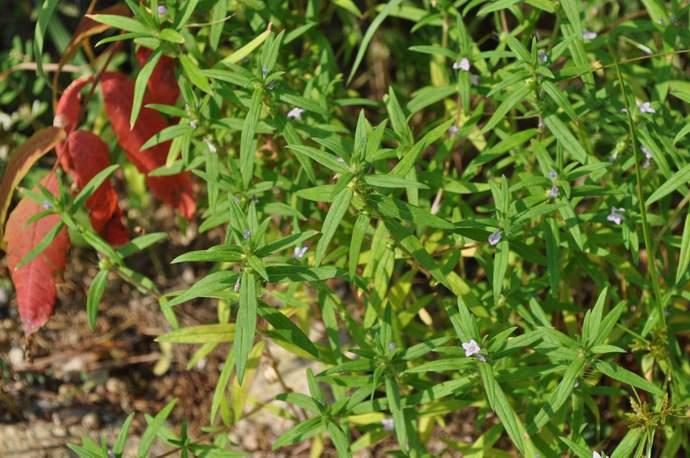
Flowering - March - June.
Habitat - Disturbed sites, lawns, roadsides, railroads.
Origin - Native to Europe.
Other info. - This little annual species can be found in scattered Missouri counties and is becoming more with time.
Many species of Cerastium look alike and can be hard to differentiate. Sometimes minute details such as cilia at the base of the tiny petals are needed to differentiate species. Typically plants need to be collected in both flower and fruit to get a proper identification.
C. brachypetalum can be identified by its annual habit, dense hairs, ciliate-based petals, and long fruiting pedicels. When growing in sunny areas, the plant typically has a distinct grayish appearance. In shady areas, the grayish appearance is mostly absent.
Stems - No info yet.

Leaves - No info yet.
Inflorescence - No info yet.

Flowering - March - June.
Habitat - Disturbed sites, lawns, roadsides, railroads.
Origin - Native to Europe.
Other info. - This little annual species can be found in scattered Missouri counties and is becoming more with time.
Many species of Cerastium look alike and can be hard to differentiate. Sometimes minute details such as cilia at the base of the tiny petals are needed to differentiate species. Typically plants need to be collected in both flower and fruit to get a proper identification.
C. brachypetalum can be identified by its annual habit, dense hairs, ciliate-based petals, and long fruiting pedicels. When growing in sunny areas, the plant typically has a distinct grayish appearance. In shady areas, the grayish appearance is mostly absent.
0
0
文章
Dummer. ゛☀
2017年06月30日

Veronica, Arabia
Persian Veronica, Latin name Veronica, persica, Poir.
Arabia is a cashier, mother-in-law
Scrophulariaceae veronical
Geographical distribution of Veronica, Arabia
Native to Western Asia to Iran and europe. At present, China is mainly distributed in East China, central China and Western china.
Morphological characteristics of Veronica in Arabia
Veronica in Arabia is a branched herb with a villous surface. Stems branched from base, lower part on ground, leaf blade opposite at base of stem, upper leaves alternate. Leaves 2-4 pairs, ovate or round, petiole shorter, leaf base shallowly cordate, blade margin obtuse, upper and lower two surfaces sparsely villous. Arabia Veronica flower alone in the axil, the Corolla is light blue, petals on the radiation of dark blue stripes; bracts alternate, with leaves of the same shape, and similar size. Capsule is kidney shape, the surface by glandular hairs, mature almost hairless, reticulate veins are obvious, the lobes are blunt. There is a deep horizontal line on the back of the seed, the florescence is in 3-5 months.
Gardening value of Veronica, Arabia
Arabia speedwell two vigorous growth period at the end of November and the month of 3~4. Because Veronica, Arabia, has a strong asexual capacity, she can plant Veronica on a bare surface that can quickly cover the surface.
The main dangers of Veronica in Arabia
Arabia speedwell as invasive species, with no natural predators, breed very quickly, will harm the summer crops and autumn crop seedlings, a variety of parasitic pathogens on roots in the plant and spread to other crops.
The breeding of Veronica in Arabia
Arabia Veronica can not only sexually reproduce, but also through asexual reproduction to maintain population reproduction, asexual reproduction can effectively reduce the risk of sexual reproduction. In the case of annuals, asexual reproduction ultimately results in the number of individual plants in the next growing season by sexual reproduction.
Under different densities, the asexual reproduction of Veronica officinalis in Arabia has different effects on sexual reproduction. No significant difference even in quantity, the nutrition component of the length and weight of the case, the resource allocation proportion of the number of fruit and fruit, erect on the significant or extremely significant difference. This shows that the density distribution has a certain impact conditions in parts of Arabia on sexual reproduction of Veronica and resources, in the case of high density, Arabia speedwell in order to adapt to the stronger competition pressure, may be in the process of growth of nutrition component, has no obvious effect on the reproduction and in the low; under the condition of density, intraspecific and interspecific competition pressure is smaller, thus changing all the nutritional components will significantly affect the change of dry weight and the number of Arabia mother-in-law individualplant nano fruit. Therefore, in the low density, intraspecific and interspecific competition is weak, all Arabia speedwell during vegetative growth on the sexual reproduction have obvious effect, but with the increase of the density, impact on the growth of vegetative organs of some reproductive organs will gradually weaken. In addition to the biological characteristics of Veronica in Arabia, environmental conditions may also have some effects on their vegetative growth and sexual reproduction.

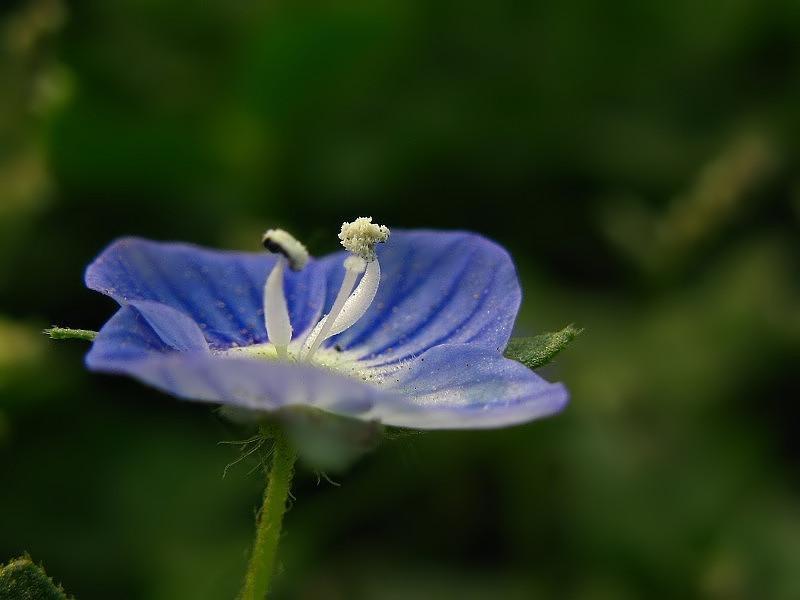
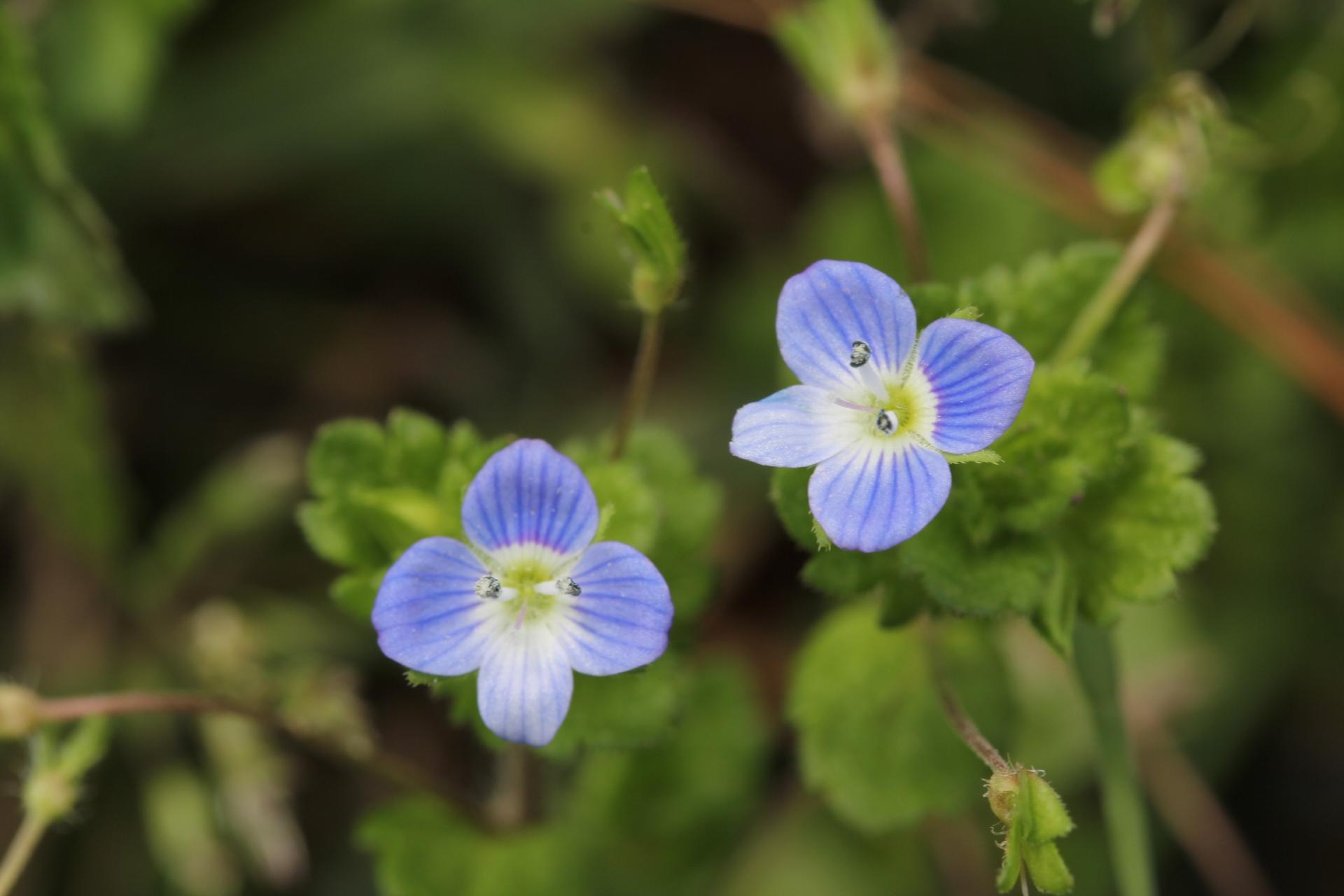
Persian Veronica, Latin name Veronica, persica, Poir.
Arabia is a cashier, mother-in-law
Scrophulariaceae veronical
Geographical distribution of Veronica, Arabia
Native to Western Asia to Iran and europe. At present, China is mainly distributed in East China, central China and Western china.
Morphological characteristics of Veronica in Arabia
Veronica in Arabia is a branched herb with a villous surface. Stems branched from base, lower part on ground, leaf blade opposite at base of stem, upper leaves alternate. Leaves 2-4 pairs, ovate or round, petiole shorter, leaf base shallowly cordate, blade margin obtuse, upper and lower two surfaces sparsely villous. Arabia Veronica flower alone in the axil, the Corolla is light blue, petals on the radiation of dark blue stripes; bracts alternate, with leaves of the same shape, and similar size. Capsule is kidney shape, the surface by glandular hairs, mature almost hairless, reticulate veins are obvious, the lobes are blunt. There is a deep horizontal line on the back of the seed, the florescence is in 3-5 months.
Gardening value of Veronica, Arabia
Arabia speedwell two vigorous growth period at the end of November and the month of 3~4. Because Veronica, Arabia, has a strong asexual capacity, she can plant Veronica on a bare surface that can quickly cover the surface.
The main dangers of Veronica in Arabia
Arabia speedwell as invasive species, with no natural predators, breed very quickly, will harm the summer crops and autumn crop seedlings, a variety of parasitic pathogens on roots in the plant and spread to other crops.
The breeding of Veronica in Arabia
Arabia Veronica can not only sexually reproduce, but also through asexual reproduction to maintain population reproduction, asexual reproduction can effectively reduce the risk of sexual reproduction. In the case of annuals, asexual reproduction ultimately results in the number of individual plants in the next growing season by sexual reproduction.
Under different densities, the asexual reproduction of Veronica officinalis in Arabia has different effects on sexual reproduction. No significant difference even in quantity, the nutrition component of the length and weight of the case, the resource allocation proportion of the number of fruit and fruit, erect on the significant or extremely significant difference. This shows that the density distribution has a certain impact conditions in parts of Arabia on sexual reproduction of Veronica and resources, in the case of high density, Arabia speedwell in order to adapt to the stronger competition pressure, may be in the process of growth of nutrition component, has no obvious effect on the reproduction and in the low; under the condition of density, intraspecific and interspecific competition pressure is smaller, thus changing all the nutritional components will significantly affect the change of dry weight and the number of Arabia mother-in-law individualplant nano fruit. Therefore, in the low density, intraspecific and interspecific competition is weak, all Arabia speedwell during vegetative growth on the sexual reproduction have obvious effect, but with the increase of the density, impact on the growth of vegetative organs of some reproductive organs will gradually weaken. In addition to the biological characteristics of Veronica in Arabia, environmental conditions may also have some effects on their vegetative growth and sexual reproduction.



0
0
文章
Dummer. ゛☀
2017年06月30日

Also known as field poppies (field poppy) or Flanders poppy.
The scientific name is Papaver rhoeas.
Poppy, (Papaveraceae) (Abraham biennial) annual plant, native to Europe, North Africa and Asia, has been introduced to Australia, New Zealand and North america.
Peanut in 25W64; 90 cm (10W64; 35 inches) tall on stem top, ca. 7W64 in diam., 10 cm. Petals 4, usually bright red, sometimes with a black spot at the base.
Once widely cultivated poppy weed distribution in seed dormancy years in soil, in the soil by plowing when germination.
During the first World War and after the war, war-torn land opening times of poppy, poppy and become a symbol of the war.
Poppy Shirley (Shirley poppy) is one of the most commonly cultivated species of garden poppy, poppy bred by.
Poppy can be a red dye used as extraction agent of some Tim color wine and drugs.
In fact, a poppy is poppy, because all plant Ranunculus orders, poppy, poppy, are called poppy.
However, most poppies are planted, but the poppy, poppy, opium poppy, poppy, and poppy seeds of the genus Papaver can be used for the manufacture of narcotic drugs, and the State prohibits the cultivation.
Europe, sub continent temperate zone, the world each place has the cultivation, Belgium regards it as the national flower.
Now in China poppy widely cultivated in Jiangsu and Zhejiang provinces most. Is the fine spring flower beds, flower border and beautify the courtyard, also but potted or cut.

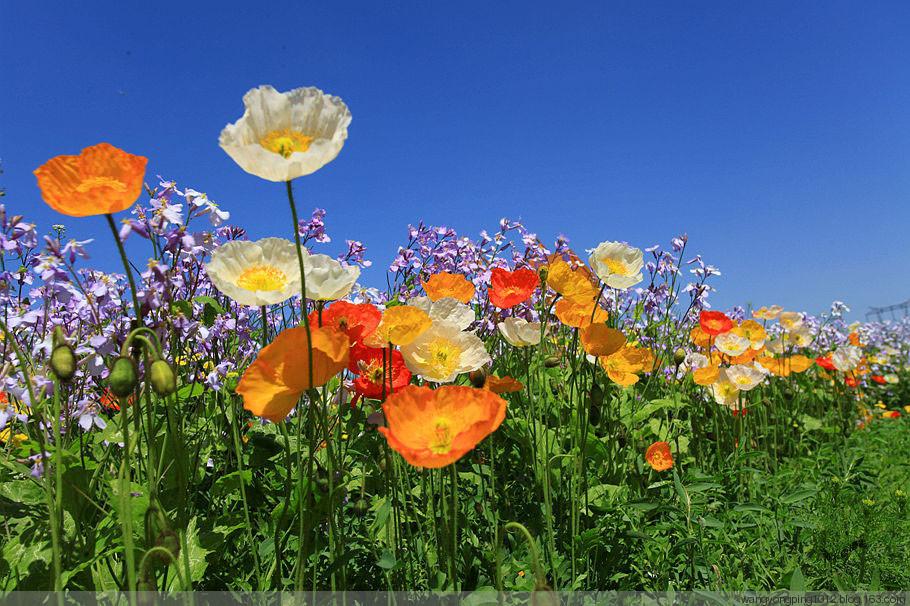

The scientific name is Papaver rhoeas.
Poppy, (Papaveraceae) (Abraham biennial) annual plant, native to Europe, North Africa and Asia, has been introduced to Australia, New Zealand and North america.
Peanut in 25W64; 90 cm (10W64; 35 inches) tall on stem top, ca. 7W64 in diam., 10 cm. Petals 4, usually bright red, sometimes with a black spot at the base.
Once widely cultivated poppy weed distribution in seed dormancy years in soil, in the soil by plowing when germination.
During the first World War and after the war, war-torn land opening times of poppy, poppy and become a symbol of the war.
Poppy Shirley (Shirley poppy) is one of the most commonly cultivated species of garden poppy, poppy bred by.
Poppy can be a red dye used as extraction agent of some Tim color wine and drugs.
In fact, a poppy is poppy, because all plant Ranunculus orders, poppy, poppy, are called poppy.
However, most poppies are planted, but the poppy, poppy, opium poppy, poppy, and poppy seeds of the genus Papaver can be used for the manufacture of narcotic drugs, and the State prohibits the cultivation.
Europe, sub continent temperate zone, the world each place has the cultivation, Belgium regards it as the national flower.
Now in China poppy widely cultivated in Jiangsu and Zhejiang provinces most. Is the fine spring flower beds, flower border and beautify the courtyard, also but potted or cut.



0
0
文章
Andrea
2017年05月22日


I’ve always loved having edibles in my garden. It isn’t a new idea, cottage gardens in Europe traditionally combined growing vegetables for the family along with table flowers, due to the small spaces most people had in those times. And cottage gardening continues to be one of the most popular gardening styles, because of the charm and possibilities that those type of gardens hold. I suppose there is something satisfying about an ornamental edible garden that touches on our needs for survival, but acknowledges our need for beauty. And so it perseveres, but edible gardens for beauty lost their appeal in the new century. Fortunately, with the new awareness of “green” living, and the DIY movement in design, gardeners are looking at their spaces in new ways. We don’t plant any longer within a structure of “rules”. We plant, and design, for that matter, leaning towards trying things that are new, pushing the envelope a bit, and being unique.
Ornamental edible gardens are becoming hot… with small spaces common and the desire to grow at least some of our own food, we need to see this more!
Some easy guidelines for growing ornamental edibles?
Remember to balance edibles that have a short growing season with edibles that are evergreen, or at least last all season. You don’t want a big hole in your garden when the lettuce is down for the summer.
Edibles can include herbs, veggies, fruits and some flowers too!
Remember texture is very important in an edible garden.
Don’t forget that the color of fruit or veggies affect the design as well. Hot peppers look great in glossy green, but add a pop of red when they mature!
Remember the basics… shade plants in shade gardens, sun in sun gardens. That having been said, most edible gardens will do better with 6 hours or more of sun a day. Some edibles, such as lettuce and some herbs, prefer afternoon shade. Plan accordingly.
Watch for pests, and treat as necessary. However, integrating herbs into your edible design can actually help minimize some pest problems.
Some ideas for ornamental edible plants?
Red and green leaf lettuce.
Cabbages
Other greens, such as red swiss chard and celery.
Herbs
Artichokes
Edible flowers such as roses, day lilies, pansies, nasturtiums and honeysuckle
Fruit trees and bushes. Blueberry blushes are especially handsome plants.
Still not convinced an ornamental edible garden can be beautiful?

Cabbage and tulips!

A pretty lettuce border.

Herbs used in a formal design.

Cabbage in a boxwood border.

Herbs in a beautiful combination border by Rosalind Creasy.
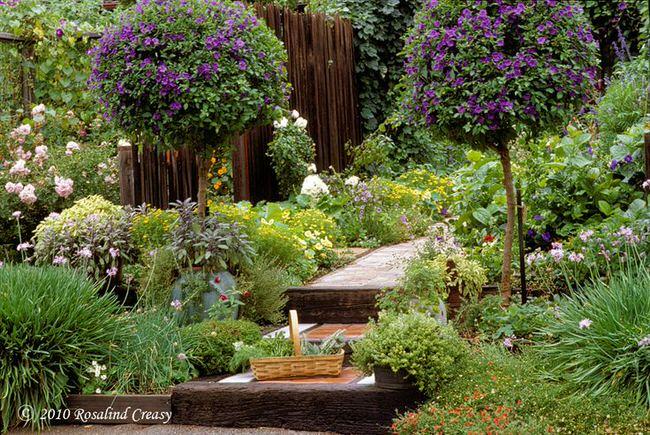
0
0
文章
Abigal
2017年02月16日

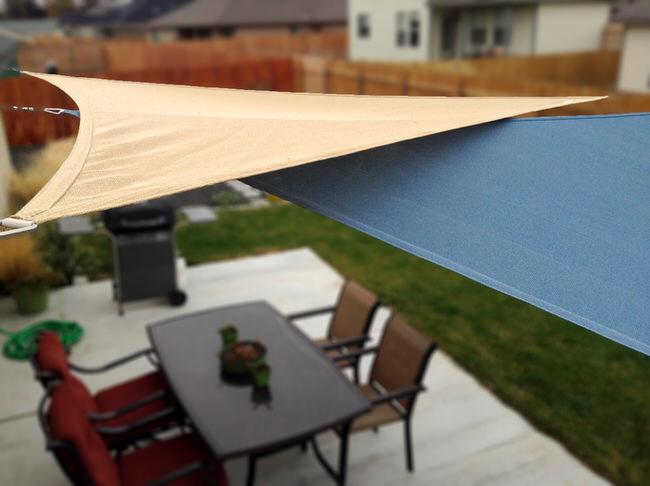
Steve and I were looking for an outdoor patio cover that was a little different, and that didn’t require major construction either. We found it in shade sails. Popular in Europe for quite awhile, they are catching on in the US quickly because of their ease of installation, ability to adjust them to each lighting situation, and let’s face it… they are just plain awesome. If you want to use shade sails to cover your outdoor room, this is how to install them, and to get around the issues these types of coverings present.
Buy your shade sails to cover the area you intend. There are many brands, shapes and sizes. Be careful you don’t purchase ones made of cheap materials, unless you only expect them to last one season. We bought Cooleroo brand from Amazon. They have lasted us three seasons so far, without fading. They come with all the hardware to hang, though you can buy an extra hardware kit if you need it. You should have mounting brackets and turnbuckles, which tighten to adjust. We preferred to layer several triangle shaped sails, but if you prefer, they come in squares and rectangles too. If I didn’t have Steve to think through the triangle thing, I would have gone with a rectangle. Sounds simpler, but not as cool!

Installing the shade sails is as easy as making sure you have strong supports, such as the side of a building, or a post. Keep in mind, these shade sails require a lot of tension to get them to stretch tight enough so that they look right, and don’t flap around in the wind. Make sure you attach them to a stud on a building, a sturdy metal pole, or learn how to make a wooden post work, as we did. (More on that below!)
The first challenge we encountered is that our sturdy supports were not close enough together to directly attach the three sides of the triangle. We laid out the shade sails on the ground in the manner in which we wanted to hang them, then measured how much we would need to extend each end to reach a fastener. Then we mounted the brackets at each corresponding support with a drill and screws. We got some metal cable and crimps from home depot. The metal cable goes through one end of the crimp, loops through the buckle on the shade sail, then back through the other side of the crimp. See photo, below. Use a hammer to pound the crimp closed, and it locks it tight.
Measure the length to the turnbuckle for the opposite fastener, and create another loop at that end. It doesn’t have to be a perfect measurement because the turnbuckle tightens down. Make sure when you measure the length of your extension wire, the turnbuckle is adjusted at its most open position. That way, you have room to tighten it down. It will tighten more then you think. When you have extension wire made for all the ends that needs it, move to the next step.

Attach the turnbuckles to the mounting bracket, and loop the extension end of the wire onto the open end of the turnbuckle, tighten each turnbuckle until the sail is taut.
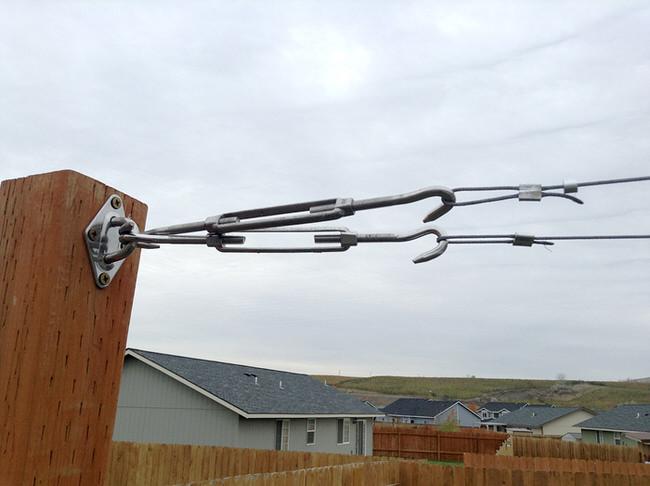
Now you want to really tighten the turnbuckles. We stuck a screwdriver throughout the open body of the turnbuckle, and used it to turn the buckle when it got tight, to tighten it even further. Tighten each end a little at a time, so that all the ends tighten evenly.

We mounted one of our mounting brackets lower on a pole, so that we could angle one of the sails against the afternoon sun.


This last photo, below, gives you a picture of one of our issues with the wooden poles we used as supports. (Please ignore the ugly patio, these photos were right after I moved in!) We installed these poles ourselves for the purpose of mounting the shade sails. (We also hang bird feeders off them!) We used several bags of concrete and buried them two feet under, 4×4 pressure treated lumber. When we attached the extension wires and tightened them down, they still bent! That is what we mean when we say a lot of tension! Possibly that won’t be an issue for you, or you will decide the slight amount of bending of the pole doesn’t bother you, (Steve’s a perfectionist… and it’s a good thing, too, or we never would have pulled this off to look so great! Me? I would have planted a vine on it and called it done. Yes, I can be a little lazy. :)) But if you decide to go with our brilliant plan, we found a fix. We used the same metal cable, and braced the pole by wiring it down to the base of a fence post that is also cemented in the ground, you can see a touch of the cable to the right side of the photo…. I know, sounds like a lot… But it turned out to be awesome! Any questions? In the end we found out that if you need to use poles to attach to, the best thing would be very sturdy 4 to 5 inch (diameter) metal poles.

Want to see more shade sails used to make amazing outdoor spaces? Be inspired!





0
0
成长记
Plants Encyclopdias
2016年08月17日

Name: Common Myrtle
Latin: Myrtus communis
Origin: Europe
Plant height: 60 - 100 cm
Reproduction: #Stems
Difficulty level: #Medium
Tags: #Europe #Myrtuscommunis
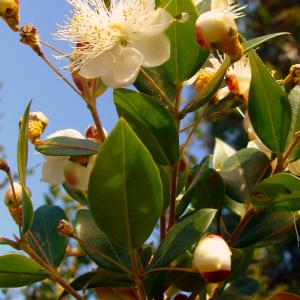
Latin: Myrtus communis
Origin: Europe
Plant height: 60 - 100 cm
Reproduction: #Stems
Difficulty level: #Medium
Tags: #Europe #Myrtuscommunis

0
0


